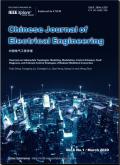Research Progress on Functionally Graded Materials for Epoxy Insulators in HV GIL/GIS
IF 3.5
Q1 Engineering
引用次数: 0
Abstract
Gas-insulated transmission lines and switchgears (GILs/GISs) are essential components that constitute ultra-high-voltage power transmission and transformation systems. Epoxy-based insulators, as core components, experience significant electric field distortions and consequent flashover faults. Since the 1980s, researchers have focused on utilizing dielectric functionally graded materials (FGMs) to improve the electric field distribution of insulators. The key research on FGMs for GIL/GIS insulators over the past half-century is reviewed. The development from bulk-FGMs to surface-FGMs, and eventually to multi-FGMs are outlined. Bulk-FGMs are typically used in AC systems. These materials provide a more uniform electric field distribution by creating a gradient in the relative permittivity within the insulator's bulk. Surface-FGMs are commonly employed in DC systems, and they regulate the electric field by designing a surface conductivity gradient, thus preventing internal breakdowns that result from bulk conductivity gradients. In practice, GIL/GIS insulators are exposed to complex operating conditions, including AC, DC, and transient voltages, resulting in the development of multi-FGMs. These combine both conductivity and permittivity gradients, thus providing a comprehensive solution for suppressing both dynamic and static electric field distortions. An effective reference for researchers and industry professionals to support the transition of the research on FGM insulators from laboratory studies to practical engineering applications is provided.高压GIL/GIS环氧绝缘子功能梯度材料研究进展
气体绝缘输电线路和开关设备(GILs/GISs)是构成超高压输变电系统的重要组成部分。环氧基绝缘子作为核心部件,会产生明显的电场畸变,从而产生闪络故障。自20世纪80年代以来,研究人员一直致力于利用介电功能梯度材料(fgm)来改善绝缘体的电场分布。综述了近半个世纪以来GIL/GIS绝缘子残基复合材料的研究进展。概述了从大块女性生殖器切割到表面女性生殖器切割,最后到多女性生殖器切割的发展。bulk - fgm通常用于交流系统。这些材料通过在绝缘体内部产生相对介电常数的梯度来提供更均匀的电场分布。表面- fgm通常用于直流系统,它们通过设计表面电导率梯度来调节电场,从而防止由整体电导率梯度引起的内部击穿。在实践中,GIL/GIS绝缘子暴露在复杂的工作条件下,包括交流、直流和瞬态电压,导致多fgm的发展。这些结合了电导率和介电常数梯度,从而为抑制动态和静态电场畸变提供了全面的解决方案。为研究人员和行业专业人员提供了一个有效的参考,以支持FGM绝缘体的研究从实验室研究过渡到实际工程应用。
本文章由计算机程序翻译,如有差异,请以英文原文为准。
求助全文
约1分钟内获得全文
求助全文
来源期刊

Chinese Journal of Electrical Engineering
Energy-Energy Engineering and Power Technology
CiteScore
7.80
自引率
0.00%
发文量
621
审稿时长
12 weeks
 求助内容:
求助内容: 应助结果提醒方式:
应助结果提醒方式:


